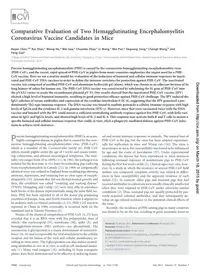
2012 Comparative Evaluation of Two Hemagglutinating Encephalomyelitis Coronavirus Vaccine Candidates in Mice PDF
Preview 2012 Comparative Evaluation of Two Hemagglutinating Encephalomyelitis Coronavirus Vaccine Candidates in Mice
Comparative Evaluation of Two Hemagglutinating Encephalomyelitis Coronavirus Vaccine Candidates in Mice Keyan Chen,a,b Kui Zhao,a Wenqi He,a Wei Gao,a Chuanbo Zhao,a Li Wang,a Wei Pan,a Deguang Song,a Chengli Wang,b and Feng Gaoa College of Animal Science and Veterinary Medicine, Jilin University, Changchun, China,a and Laboratory Animal Department, General Hospital of Shenyang Military Area Command, Shenyang, Chinab Porcine hemagglutinating encephalomyelitis (PHE) is caused by the coronavirus hemagglutinating encephalomyelitis virus (PHE-CoV), and the recent, rapid spread of PHE-CoV in piglets from many countries emphasizes the urgent need for a PHE- CoV vaccine. Here we use a murine model for evaluation of the induction of humoral and cellular immune responses by inacti- vated and PHE-CoV DNA vaccines in order to define the immune correlates for protection against PHE-CoV. The inactivated vaccine was composed of purified PHE-CoV and aluminum hydroxide gel (alum), which was chosen as an adjuvant because of its long history of safety for human use. The PHE-CoV DNA vaccine was constructed by subcloning the S1 gene of PHE-CoV into the pVAX1 vector to create the recombinant plasmid pV-S1. Our results showed that the inactivated PHE-CoV vaccine (IPV) elicited a high level of humoral immunity, resulting in good protection efficacy against PHE-CoV challenge. The IPV induced the IgG1 subclass of serum antibodies and expression of the cytokine interleukin-4 (IL-4), suggesting that the IPV generated a pre- dominantly Th2-type immune response. The DNA vaccine was found to mediate primarily a cellular immune response with high levels of IgG2a and the cytokines IL-2 and gamma interferon (IFN-�). However, mice that were vaccinated twice with the DNA vaccine and boosted with the IPV could mount a sufficient neutralizing antibody response against live PHE-CoV, with little vari- ation in IgG1 and IgG2a levels, and showed high levels of IL-2 and IL-4. This response may activate both B and T cells to mount a specific humoral and cellular immune response that could, in turn, elicit a phagocyte-mediated defense against PHE-CoV infec- tions to achieve viral clearance. P orcine hemagglutinating encephalomyelitis (PHE) is an acute, highly contagious disease in piglets that is caused by the coro- navirus hemagglutinating encephalomyelitis virus (PHE-CoV), which is a member of the Coronaviridae family (6). PHE-CoV infects mainly piglets under the age of 3 weeks and causes vomit- ing, exhaustion, and obvious neurological symptoms. The mor- tality rate ranges from 20 to 100% (11). In 1962, the pathogen was isolated for the first time in vivo from breastfeeding pigs suffering from encephalomyelitis in Canada (12). In 1969, an antigenically identical virus was isolated in England from suckling pigs showing anorexia, depression, and vomiting but no clear signs of enceph- alomyelitis (10). Animals that did not die had stunted growth, and thus, the condition was called “vomiting and wasting disease” (VWD). Mengeling and Cutlip (22) were later able to reproduce both forms of the disease experimentally using the same field iso- lates. PHE has been reported in all of the major pig-producing countries of Europe, Asia, and North America, where it appears to be endemic with no clinical outbreaks (5, 22). PHE-CoV was first reported in China in 1986; eventually, it occurred both on the mainland and in Taiwan Province (6). Studies of the chemical composition of PHE-CoV (4, 23) have revealed that it is an RNA virus with five polypeptides, four of which—the nucleocapsid (N), membrane (M), spike (S), and hemagglutinin-esterase (HE) proteins—are glycosylated. The coronavirus S glycoprotein is a major determinant of neuroviru- lence (16, 34) and is responsible for viral attachment to the cellular receptor and for fusion of the viral and cellular membranes, re- sulting in virus entry. The S glycoprotein can also induce neutral- izing antibodies in vivo or in vitro, as well as cell-mediated immu- nity (1). Many viral antigens (19), including S1 from transgenic plants, have been demonstrated to be effective at inducing muco- sal and serum immune responses in animals. The natural host of PHE-CoV is the pig, but the virus has been adapted experimen- tally for replication in mice and Wistar rats (36). The virus is neurotropic in mice, but susceptibility was found to be influenced by age and the route of inoculation (37). Under experimental conditions, the disease has been reproduced in most instances following oronasal exposure of nonimmune pigs to PHE-CoV during the first few weeks of life (2). Clinical signs may vary, how- ever. In a study in which the virulence of several PHE-CoV field isolates was compared, symptom severity was related to differ- ences in host susceptibility and the apparent virulence of each isolate (22). In contrast, older pigs and neonatal pigs that had received antibodies in colostrum were usually clinically unaffected when they were exposed to PHE-CoV under otherwise similar conditions (2). Thus, neonatal pigs are usually protected by pas- sively acquired colostral antibodies, and they subsequently de- velop an age-related resistance to the potential clinical effects of the virus. Recently, the incidence of PHE among pigs in many countries was found to be on the rise, resulting in great economic losses to Received 10 January 2012 Returned for modification 30 January 2012 Accepted 30 March 2012 Published ahead of print 18 April 2012 Address correspondence to Chengli Wang,
